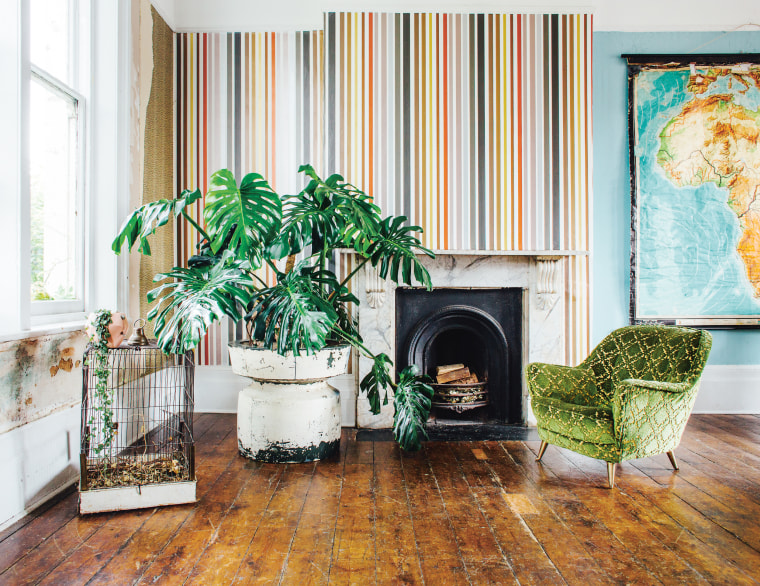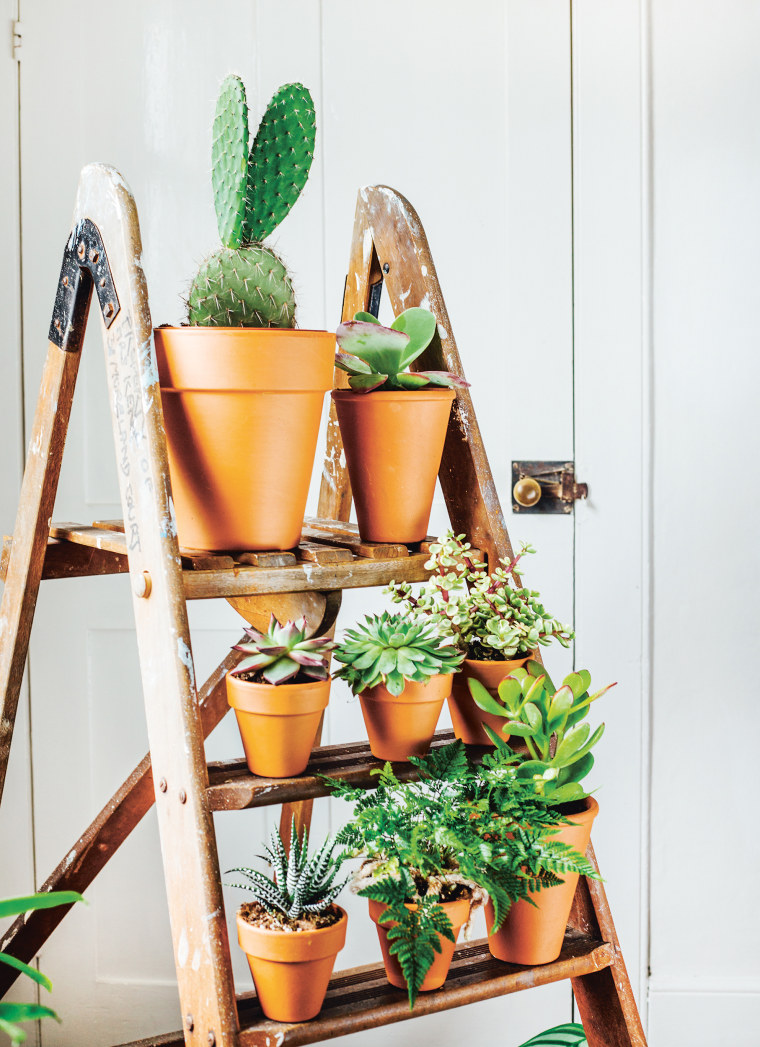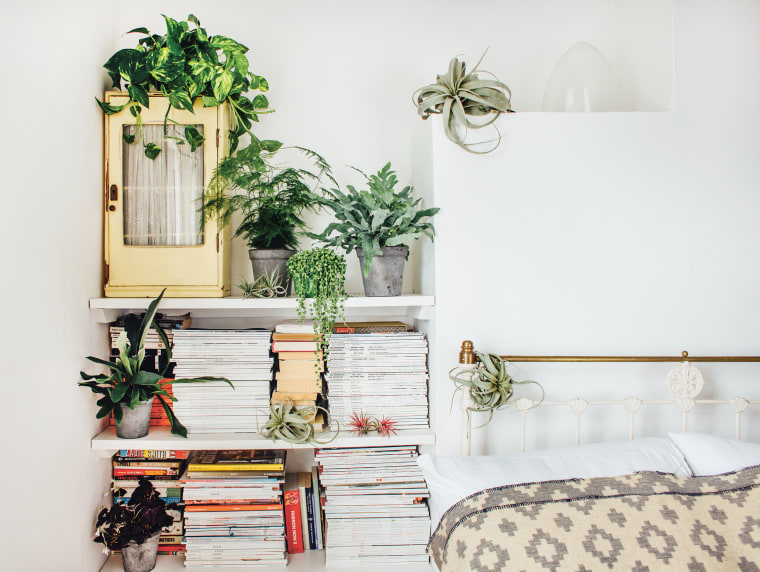Houseplants are good for your health — and not just for their visual beauty. Why? They essentially do the opposite of what we do when we breathe: release oxygen and absorb carbon dioxide. This not only freshens up the air, but also eliminates harmful toxins. Extensive research by NASA has revealed that houseplants can remove up to 87 per cent of air toxin in 24 hours. Studies have also proven that indoor plants improve concentration and productivity (by up to 15 percent!), reduce stress levels and boost your mood — making them perfect for not just your home but your work space, too.
At work, place plants, especially those with broad leaves, on your desk; they will help regulate humidity and increase levels of positivity — seeing greenery and nature help us feel more relaxed and calm, which in turn benefits your every day mood. Indoor plants serve a practical and aesthetic purpose, and will enhance your life.
How to Create your Personal Plant Sanctuary
An indoor garden can be your refuge from the outside world, and for many people it is a source of great joy. Whether you live in a small apartment, or a large house, by introducing certain plants into your home, you will start to notice improvements to your health, and overall happiness. As well as enhancing your mood and creating a living space that is soothing to be in, plants can also help with loneliness and depression: caring for a living thing gives us a purpose and is rewarding — especially when you see that living thing bloom and thrive.
Studies have proven that house plants improve concentration and productivity (by up to 15%), reduce stress levels, and boost your mood.
To create your perfect green haven, it’s worthwhile spending a little bit of time researching the plants are best suited for each room and what kind of environment. Here are a few pointers:
- Choose the right plants for the an optimal night's sleep. Although plants release oxygen during the day, it is worth remembering that, at night, when photosynthesis stops, most plants switch things up and release carbon dioxide. However plants such as orchids, succulents, snake plants and bromeliads do the opposite and emit oxygen, making them perfect plants for the bedroom (and getting better sleep).
- Beware of too much sun. Most indoor plants don’t like direct midday sun, so please be wary of this when placing plants in your home. There are very obvious warning signs to look out for, such as leaf burn, spotting or sudden leaf-fall. Most plants can be easily rescued, so don’t panic! Often it is a case of not watering them too much, or letting the soil dry out a bit if it is feeling too soggy. Check if your plant is sitting by a cold draft as this can case the leaves to curl and eventually drop off. Organic fertilizers are a great way to revive your plants.
- Plants are inexpensive way to jazz up even the most boring rooms. Plants are an easy and gorgeous way to style up your living space. Adorn your windowsills with succulents, drape vibrant macramé hangers from curtain rails or try something big and bold like the gorgeous fiddle leaf fig. You can also have fun with the pots, and display your plants in beautiful ceramic and copper containers. Owning plants doesn’t have to be expensive: just take a cutting from a friend’s plant or from your local plant shop, and propagate your plant from scratch.
- Some plants like it hot. Knowing what plants are best for what room is crucial when it comes to plant styling: the bathroom is perfect for air plants and kokedama (Japanese hanging moss ball), as the excess moisture from your daily shower helps those particular plants flourish. If you’re lucky enough to have a sunroom or a super hot room, then fill it with ferns, palms, succulents and cacti as they will love the heat.

A Beginner's Guide to Decorating With Plants
If you are new to gardening, here is a selection of plants that will suit you perfectly. All will provide you with lots of greenery, are easy to look after and reasonably priced.
- Monstera deliciosa (Swiss cheese plant): It is fairly inexpensive to buy a 12 inch Monstera and it grows quickly, so you could get some easy height and beautiful leaves in under 3 months.
- Epipremnum aureum (golden pothos or devil’s ivy): This is a great group of plants to get started with as they are relatively low maintenance. The trailing varieties sprout new leaves regularly and are great in a hanging planter such as a macramé hanger. However, they are toxic to cats and dogs.
- Hedera (ivy): Ivy is almost indestructible and has a good telltale sign when it needs watering as the leaves will look limp and soft.
- Chlorophytum comosum (spider plant): These are great low maintenance plants, which need watering from the bottom perhaps once a week and a misting every now and then. They sprout babies regularly, off the end of their leaves, that are easy to propagate; you will be inundated with baby plants, which you can then share with friends and family.

Don't Have a Green Thumb? Start With These Plants
- Start with an easy plant such as a cactus or succulent. Many people think succulents and cacti are the same thing, as most cacti are classed as succulents. However, although the majority of cacti are also succulents, there are many other succulent plants that are not cacti. The main difference is that cacti always have bumps called areoles from which hair or spikes grow, whereas other kinds of succulents do not.
- Cacti can surprise you. One of the wonderful things about cacti is that they will tolerate your terrible behavior for years and years, and then they will surprise you with flowers when they get growing again. It is a myth that cacti only flower once in a blue moon: nearly half of all healthy cacti will produce flowers by their third year if cared for correctly. Cacti flower on new growth, which is promoted by caring for them throughout the summer and neglecting them in the winter. Also, flowering is often stimulated when the plant is pot-bound (where the roots completely fill the pot). For people new to keeping house plants, this is a great plant group to get started on, as they only require a light misting of water every so often.
- Succulents are perfect first plants. They're low maintenance, easy to propagate and suited to most homes. They are best placed on the windowsill where they can get the most sunlight. Identifying a succulent is pretty straightforward, as they have thick, fleshy leaves or stems. Many types are a rosette shape and have tightly packed leaves, which help to conserve water in their natural habitat. You could simply start with an Echeveria and Sempervivum (houseleek) collection as they can provide an interesting group without any other plants and there are lots of varieties to collect.
- Never overwater. Most people kill their houseplants by pouring water down the center of the plant, giving the plant much more water than it needs, and then the water has nowhere to go so it then sits in the plant. Excess stagnant water then causes root rot, which causes the plant to die. Either water from the bottom using a saucer if the plant pot has drainage or mist regularly with an atomizer, which helps to increase the humidity around your plant and keeps your plant happy!

Sophie Lee is the owner of London homewares store Geo-Fleur, and author of the new book Living With Plants, published by Hardie Grant Books in June 2017.
